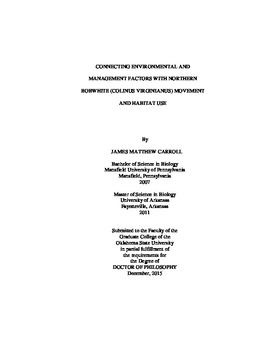| dc.description.abstract | Temperature is highly variable across space and time at multiple scales, shapes landscape pattern, and dictates ecological processes. Recently, gaining knowledge on the thermal ecology of vulnerable species has been a major focal point of ecological studies, and this focus has been heightened by predicted temperature increases associated with global climate change. For example, although ground nesting birds are susceptible to heat extremes across many reproductive stages (i.e., nesting, brood-rearing), the mechanistic drivers of site selection for these species are not well established, especially from a thermal perspective. We characterized the thermal landscape and assessed site selection of a small ground-dwelling bird species (northern bobwhite; Colinus virginianus, hereafter bobwhite) during two life stages. Specifically, we measured black bulb temperatures (Tbb) at random stratified points (n=312), bobwhite nest sites (n=87) and brood locations (n = 266) at the Packsaddle WMA in western Oklahoma, USA. We observed that the landscape was thermally heterogeneous and exhibited variation in Tbb up to 40?C during peak diurnal heating, demonstrating a wide array of thermal choices available to nesting and brood-rearing bobwhites. The landscape also displayed a prevalence for thermal extremes (i.e., Tbb >50?C), which were substantially moderated by tall woody cover. Accordingly, bobwhites selected nest and brood sites that substantially moderated Tbb. For example, nest sites moderated Tbb by more than 12?C compared to random landscape sites, and successful nests remained on average 6?C cooler than unsuccessful nests on days experiencing ambient temperatures ? 39?C. At 15:00 h, broods selected thermal refuges that moderated Tbb on average 10.4?C more than landscape sites and exhibited behavioral thermoregulation through reduced movement and by occupying more moderate microclimates in taller woody cover. Our modeled climate projections suggest that future thermal extremes will increase in intensity and extent across the landscape, as well as, at bobwhite nest and brood sites. These results highlight how landscapes can moderate thermal extremes and demonstrate how thermal complexity at organism-specific scales can dictate habitat selection. In the future, the management of thermal space for ground-nesting birds should focus on providing structural heterogeneity to promote thermal choices across life stages. | |
